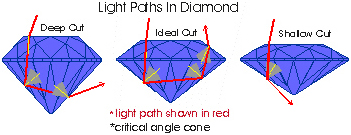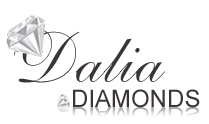Diamond Education
Learn About the 4 C's
Cut
Color
Clarity
Carat Weight
Learn about Diamond Cut
Cut is considered by many to be the most important "C". Only when precisely calculated planes and angles are used, does the diamond achieve its greatest possible beauty. A poorly cut diamond, no matter how great its color and clarity is will not compare in the sparkle and brilliance of a better-cut diamond with comparatively lower color and clarity.

Experts express differing opinions on the best table size (the diameter of the largest facet on the top of the stone) and the best depth for a diamond, because these factors alone are not sufficient to accurately judge its cut.
Other factors - crown angle, girdle thickness, pavilion depth-percentage (the ratio of depth to girdle diameter), culet size, polish and symmetry - also play a role in judging a diamond's overall cut quality.

To understand diamond cut, it helps to understand how light reacts within a diamond. When light enters a diamond or any given material it bends or refracts. The degree to which it bends is called the refractive index. The refractive index of diamond is 2.41, the highest of any natural transparent gem. In diamond the maximum angle of refraction is 24.5 degrees. This is called the critical angle. Light traveling through a diamond is reflected if it strikes a surface outside the critical angle. Light striking a surface inside the critical angle will be refracted out of a diamond. The critical angle is represented as 24.5 degree cone in the diagram.
In a well-made diamond, a high percentage of light entering through the crown starts out striking the pavilion outside the critical angle. Thus it is totally reflected to the other side of the pavilion. There it strikes outside the critical angle again, and again and is totally reflected, this time towards the crown, where it strikes within the critical angle and leaves the diamond traveling in directions in which it can be seen. Such controlled release of light is planned leakage. If the pavilion is too deep, or too shallow, much of the light strikes inside the critical angle and leaks out the back of the stone rather than reflecting through the diamond and back through the top to the eye.
Learn About Diamond Color
The color of a diamond refers to the tone and saturation of color, or the depth of color in a diamond. The color of a diamond can range from colorless to a yellow or brown hue. A more colorless diamond is rarer and more valuable because it appears white and brighter to the eye.
The COLOR GRADE SCALE classifies diamond color into 22 grades from letter grade D through letter grade Z.
Diamonds that are graded from D through J are best suited for jewelry because they look colorless or nearly colorless.

Learn About Diamond Clarity
Clarity describes the presence or absence of inclusions within the diamond and blemishes on its surface. These slight "birthmarks of nature" make every diamond quite unique. However, they do affect the beauty and value of the diamond. These natural birthmarks are often referred to as inclusions. The fewer inclusions a diamond may have the rarer and more valuable it is. Diamonds which contain numerous inclusions are less brilliant because inclusions interfere with light passing through the diamond.
Clarity grading is conducted with specially designed microscopes. Diamonds clarity is discerned using 10X magnification.
FL, IF (Flawless, Internally Flawless): These rare diamonds contain no flaws (FL) or only very insignificant blemishes (IF) when viewed under 10x magnification.
VVS1, VVS2 (Very, Very Slightly Included): The tiny inclusions in these stones are very difficult to see, even at 10x magnification. VS1, VS2 (Very Slightly Included): These stones contain inclusions that are visible only under 10x magnification.
SI1, SI2 (Slightly Included): Diamonds at this level have inclusions that are clearly visible under magnification and may be visible without magnification.
I1, I2, I3 (Included): Inclusions are clearly visible without magnification
Learn About Diamond Fluorescence
Fluorescence in some degree is common in a great percentage of diamonds. Fluorescence is a form of illumination that is created when a diamond is exposed to low or high wave ultraviolet radiation. Faint or medium fluorescence will rarely affect a diamond's appearance. Usually fluorescence is unnoticed by the human eye in ordinary light. Fluorescence can cause a diamond to appear less clear or slightly hazy if the diamond exhibits very strong or extreme fluorescence. When selecting your diamond it is best to choose a diamond that has no fluorescence or faint to moderate fluorescence.
Diamonds that possess strong fluorescence in color grades lower than the color grade of H will often face up approximately one color grade better than a non-fluorescent diamond. Strong fluorescence can actually improve the appearance of diamonds that possess traces of color. Diamonds that possess strong fluorescence in colorless to very near colorless grades D through G sometime exhibit a noticeable luminescence which can give the diamond a hazy appearance. A strong or extremely fluorescent diamond can usually be purchased for 10 to 30% less than a diamond that possesses fluorescence that is moderate or better.
Note: On GIA and other diamond grading reports, a diamond's fluorescence may be described as "None". Customers should be aware that "None" on these reports specifically means "Less than Faint", and does necessarily indicate "Absolutely No" fluorescence that one would rationally assume.
Learn About Diamond Carat Weight
The weight of a diamond is generally given in carats. The term carat originated in ancient times when gemstones were weighted against the carob bean. Each bean weighed about one carat. In 1913, carat weight was standardized internationally and adapted to the metric system. One carat equals 0.2 grams – a little more than 0.007 ounce. In other words, it takes 142 carats to equal 1 ounce.
The weight of small diamonds is frequently expressed in points, with one point equaling 0.01 carats. For example, five points is a short way of saying 5/100 of a carat.
Note that an increase in carat weight does not produce the same increase in millimeter diameter. For example, there is a 25% increase in carat weight form 1.00 carats to 1.25 carats but less than 8% increase in diameter (6.5 to 7.0mm). This concept, along with the increased price per carat, explains why prices increase dramatically in order to get noticeably bigger millimeter size.



